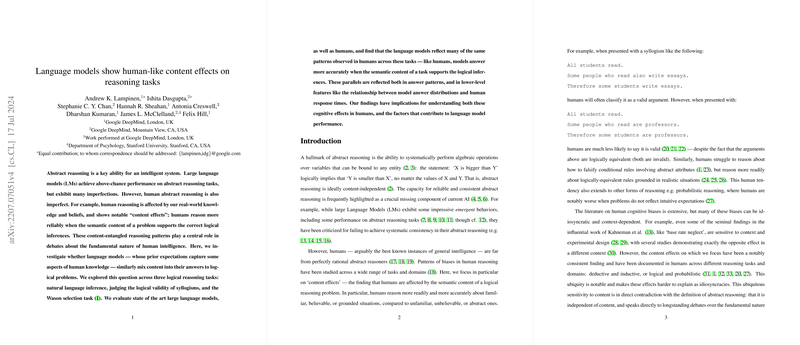Overview of Human-Like Content Effects in LLMs on Reasoning Tasks
The paper "LLMs show human-like content effects on reasoning tasks" presents an extensive investigation into the performance of LLMs (LMs) on a series of logical reasoning tasks, illuminating how these models display parallel content effects to humans. The authors focus on three specific reasoning tasks: natural language inference (NLI), syllogism validity judgment, and the Wason selection task, exploring how the semantic content of the tasks affects the performance of both humans and LLMs. This exploration sheds light on how LMs mirror human cognitive patterns, particularly the tendency to integrate semantic and contextual knowledge into logical reasoning.
Key Findings
The paper reveals several pivotal points about the capability and limitations of LMs in logical reasoning:
- Content Effects on LM and Human Reasoning: The research establishes that LMs, akin to human reasoners, exhibit significant content effects in logical reasoning. These models perform better on tasks when the semantic content aligns with realistic and believable scenarios, mirroring human reasoning biases.
- Task-Specific Observations:
- Natural Language Inference: On NLI tasks, both LMs and humans display high accuracy, indicating relatively minor content effects due to the straightforward logic involved.
- Syllogisms: This task illustrates more pronounced content effects, where both LMs and humans are biased by the believability of the conclusions. In particular, they tend to affirm the validity of syllogisms when the conclusions are consistent with their beliefs.
- Wason Selection Task: This classical logic task presents more challenges. Both humans and LLMs exhibit low performance, with individuals and models faring significantly better when the task content is framed in realistic terms.
- Confidence and Response Time Correlations: The authors delve into the confidence levels of LMs as expressed through log probabilities, finding notable correlations between model "confidence" and human response times. For instance, models express higher confidence (higher log-probability differences) when they, akin to humans, respond more quickly to a problem or when the logical inferences align with prior knowledge.
- Instruction-Tuning and Model Variability: Interestingly, instruct-tuned models did not show marked improvements in overcoming content effects compared to their base counterparts. However, model size and structure (e.g., PaLM 2 variants, GPT-3.5) influence overall task performance, suggesting an avenue for further exploration in model refinement for logical consistency.
Implications
This paper's findings have significant implications for both scientific understanding of human cognition and the practical development of AI:
- Cognitive Science Insight: The parallels between LM biases and human biases invite discussions on the cognitive mechanisms shared between learned statistical representations in humans and neural networks. Such insights encourage a deeper examination of the shared characteristics in emergent problem-solving strategies across biological and artificial intelligences.
- AI Development: Practically, understanding these content effects can guide enhancements in the training paradigms of LMs, particularly through targeted interventions such as exposure to formal reasoning tasks. Moreover, addressing these biases could inform AI applications in contexts requiring robust logical reasoning capabilities, potentially mitigating weak points in AI decision-making systems.
Future Directions
The results suggest numerous pathways for future research:
- Further studies should aim to pinpoint specific factors within the training datasets that lead to content effects in LMs, providing deeper insights into the learning processes of both humans and machines.
- Exploring the potential for an evolved model architecture that can innately balance between heuristic reasoning (system 1) and more deliberative, symbolic reasoning (system 2) could enhance models' reasoning abilities, paralleling cognitive frameworks like dual-process theories in humans.
- Investigating interdisciplinary approaches to leverage these insights in the design of next-generation AI, possibly integrating learned semantic knowledge with more explicit symbolic reasoning mechanisms, could yield AI systems with superior reasoning skills.
In conclusion, this paper underscores the nuanced alignment of LMs with human cognitive patterns, notably in logical reasoning affected by semantic content. This revelation not only broadens our understanding of AI capabilities but also enriches the discourse on the interplay between human-like inference patterns and artificial intelligence systems.
